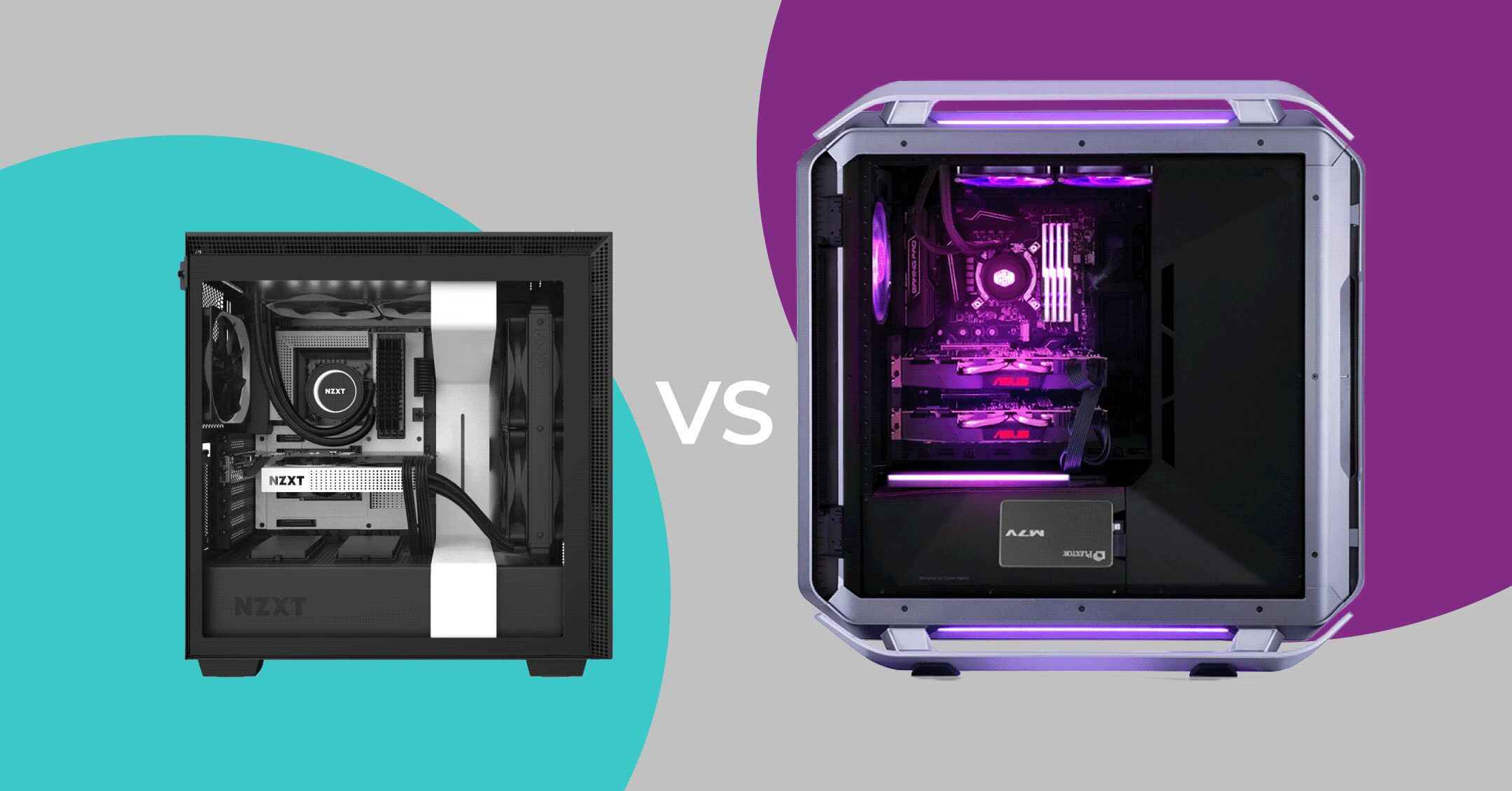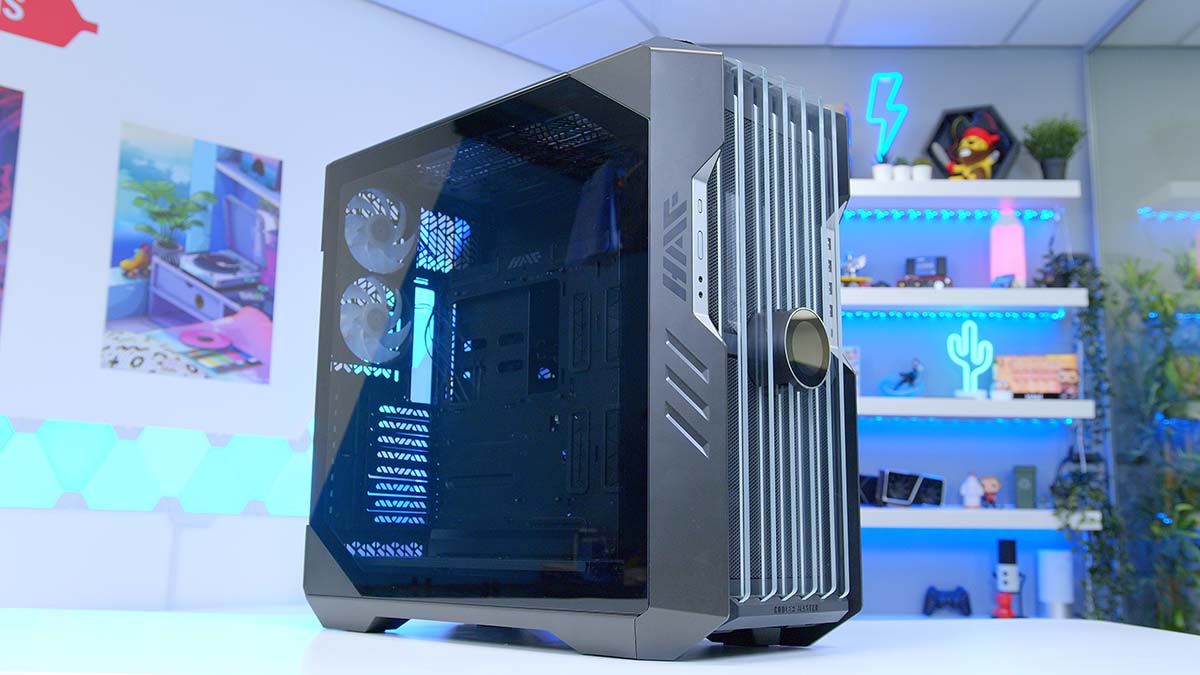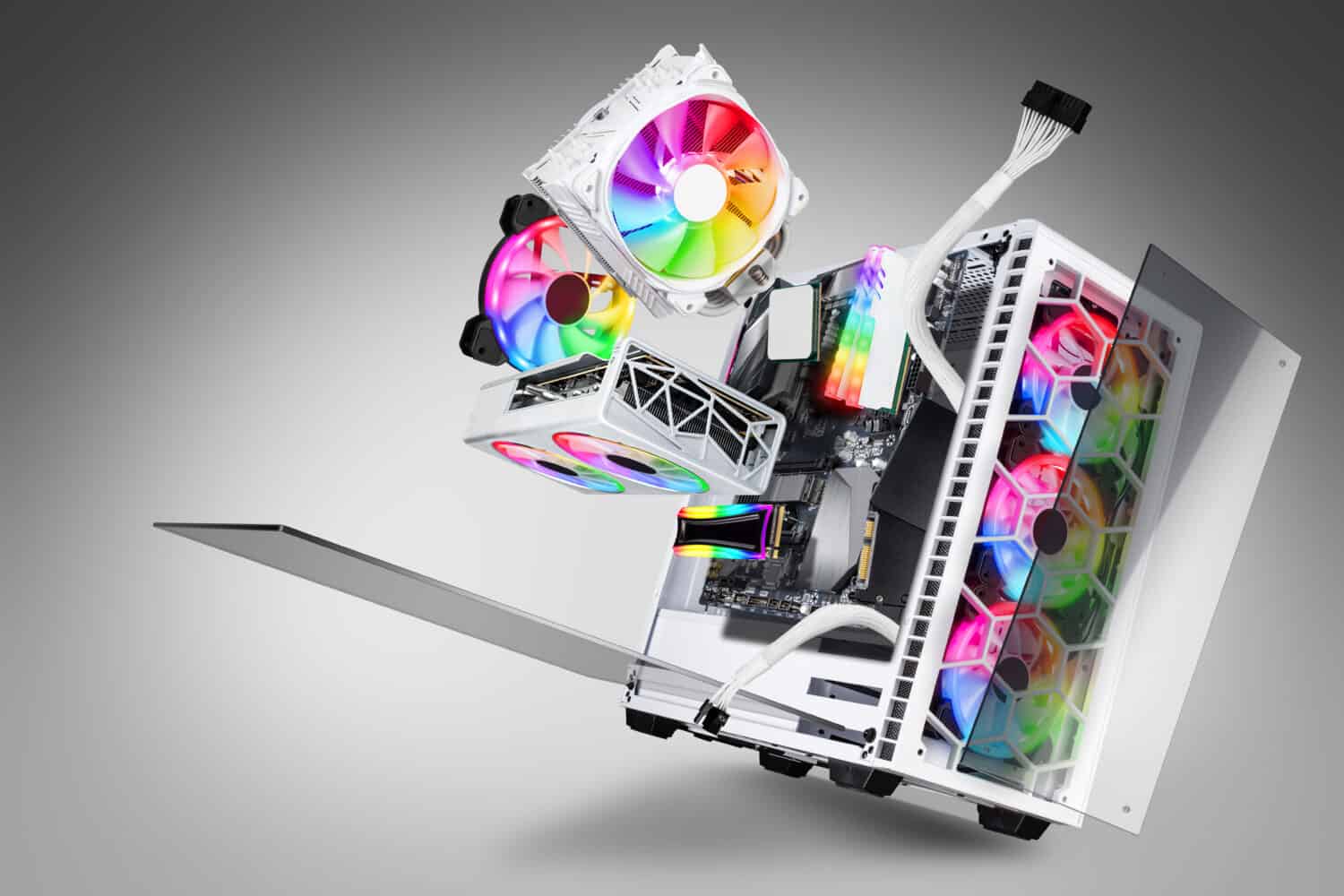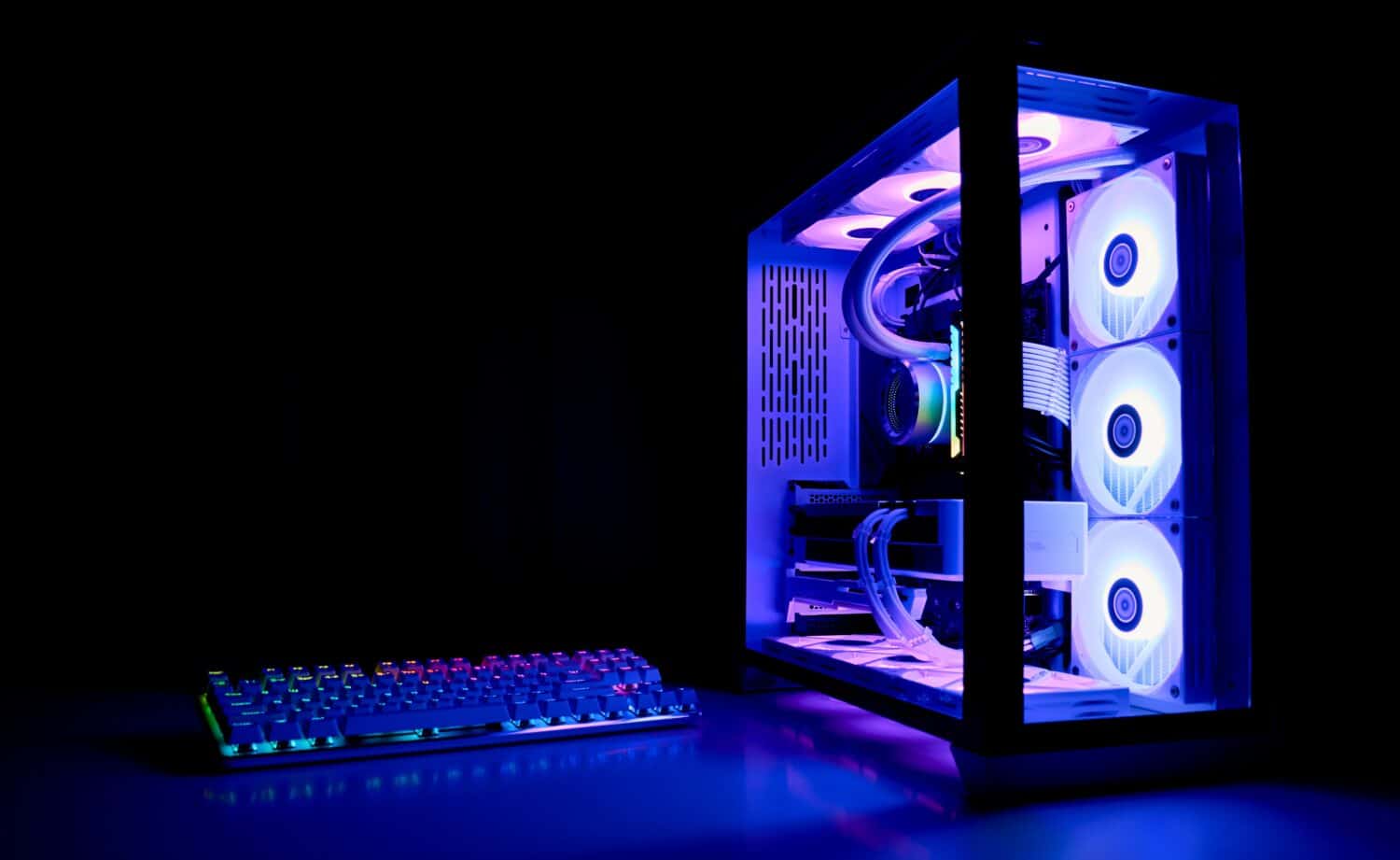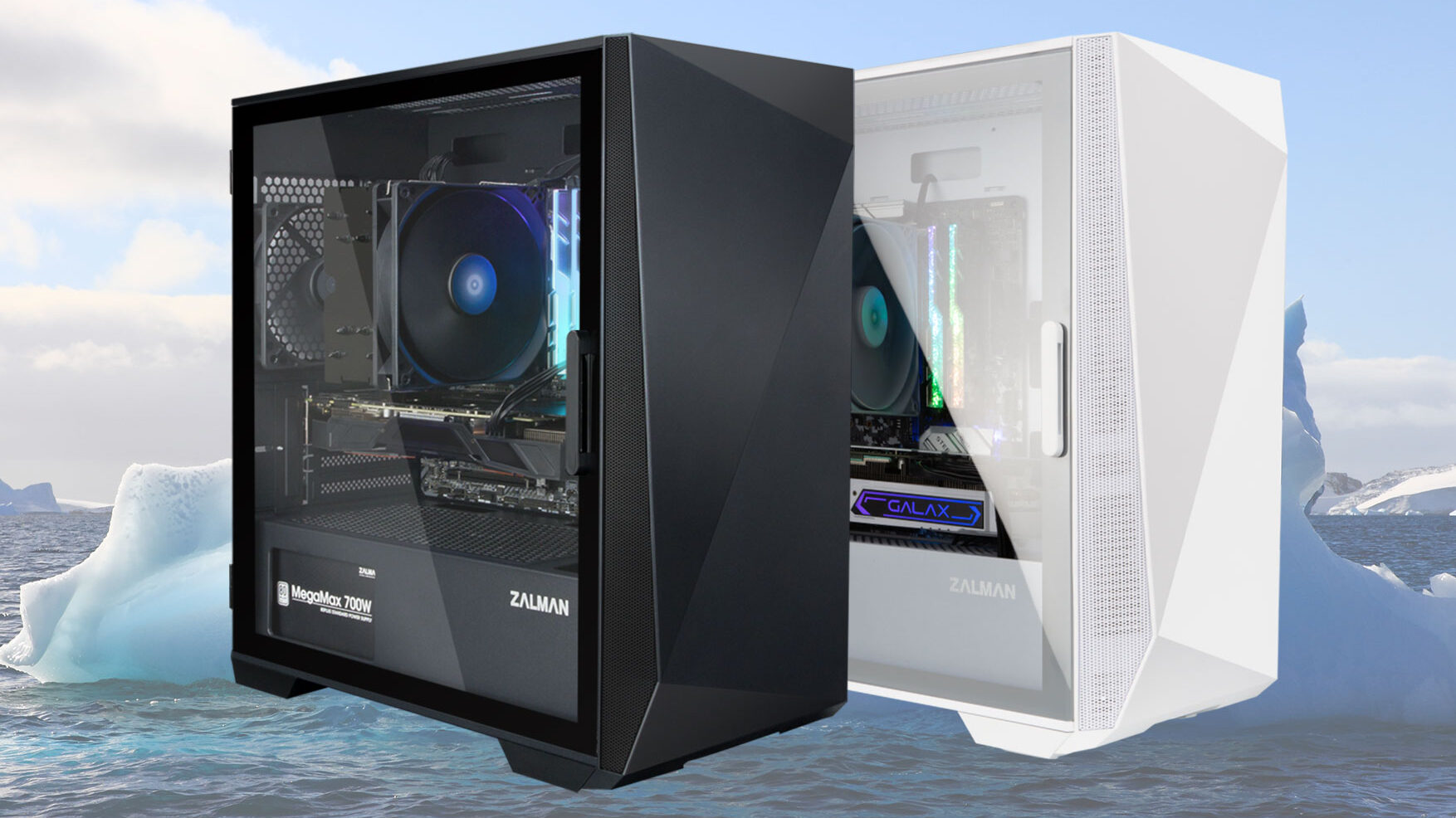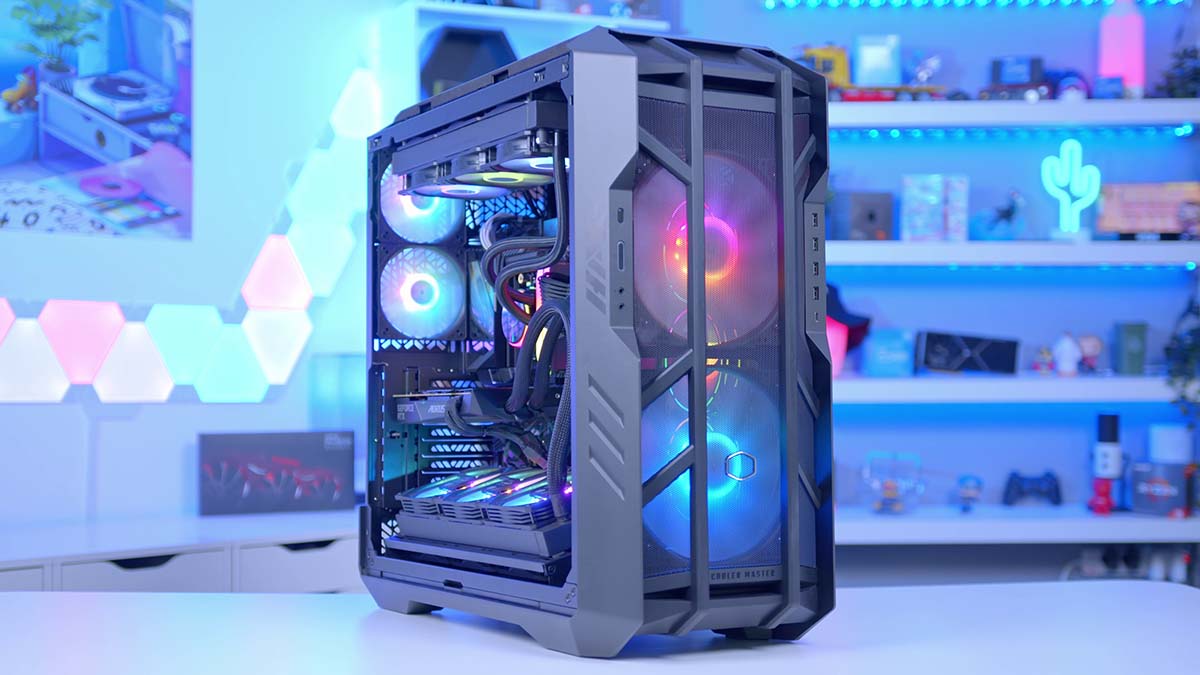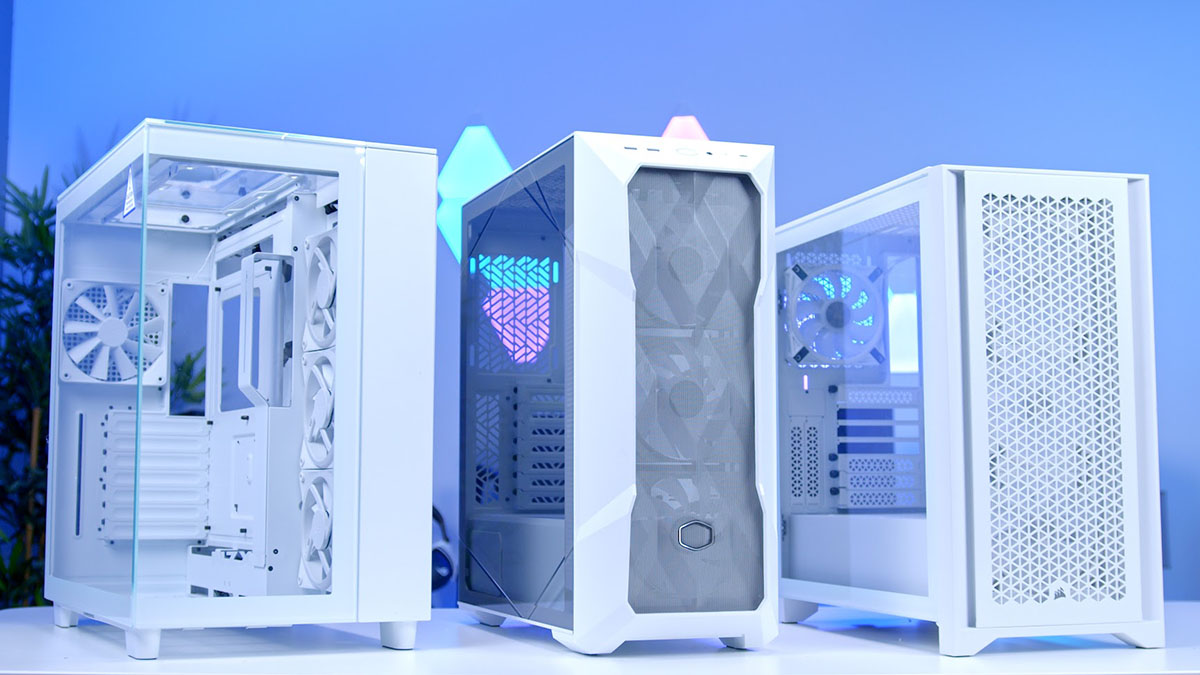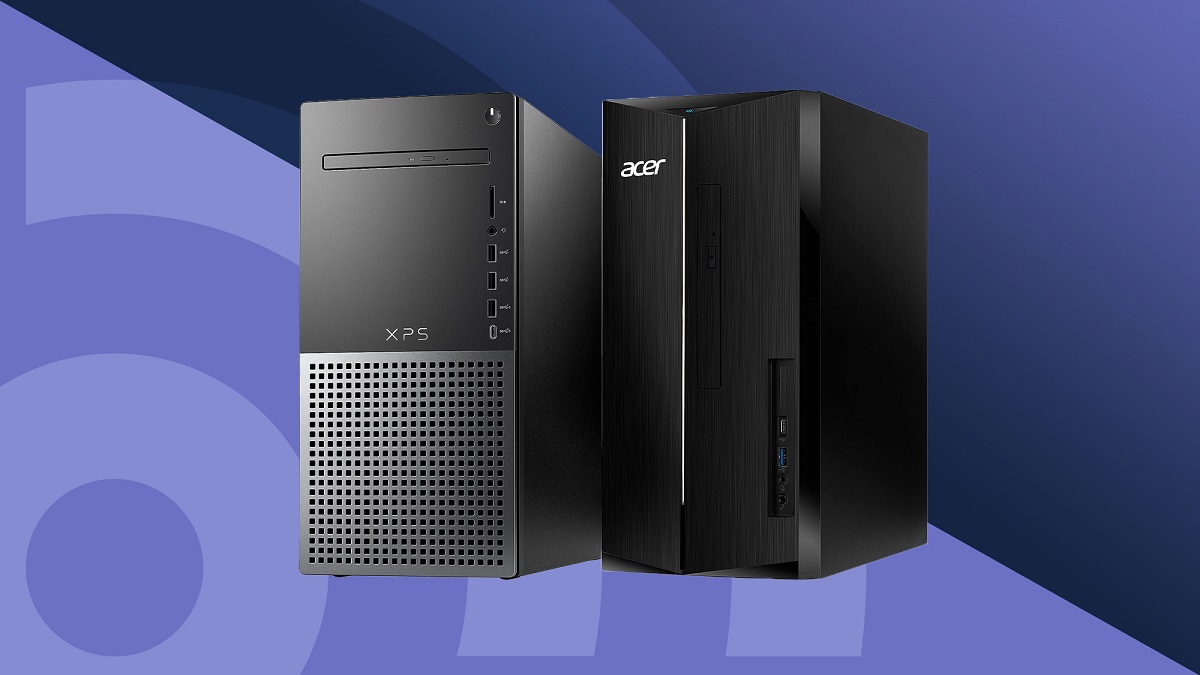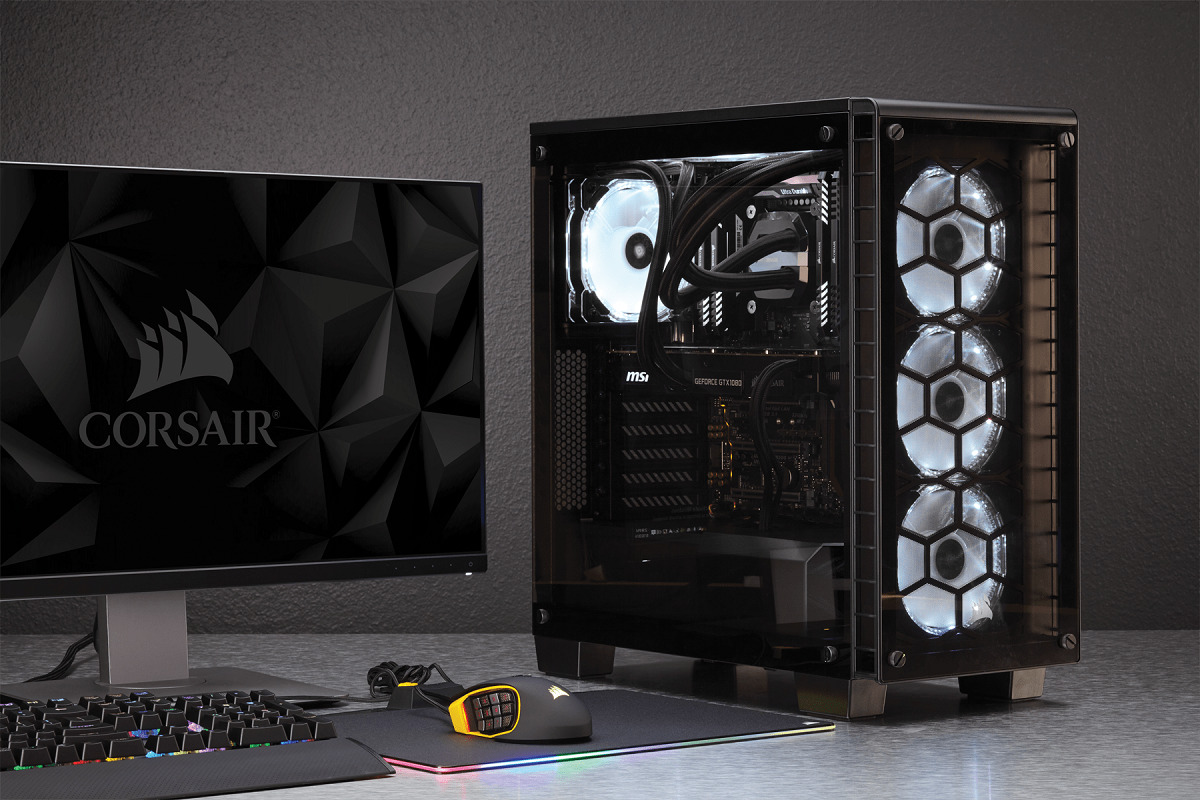How Big Is A Mid Tower PC Case?
Introduction
A mid tower PC case is a popular choice among computer enthusiasts and gamers due to its versatile size and functionality. It strikes a balance between the compactness of a mini tower case and the expansive nature of a full tower case. If you’re wondering about the dimensions of a mid tower PC case and how it compares to other types, then this article is for you.
With the rise of powerful hardware components like high-end graphics cards and advanced cooling solutions, it’s crucial to have a PC case that can accommodate these components while offering sufficient airflow and cable management options. This is where the mid tower case excels.
Mid tower PC cases come in various sizes, but they generally follow a standardized form factor. They are designed to fit standard ATX motherboards, allowing users to build powerful systems without the need for excessive space. Whether you’re a casual user, a creative professional, or a hardcore gamer, a mid tower PC case can cater to your needs by providing a compact yet functional platform for building your dream rig.
In this article, we will explore the dimensions of a mid tower PC case, compare it with other case sizes, discuss the pros and cons of using a mid tower case, and highlight the factors to consider when choosing one for your build.
What is a mid tower PC case?
A mid tower PC case is a type of computer case that falls between a mini tower and a full tower in terms of size and capacity. It is designed to accommodate standard ATX motherboards while providing enough space for essential hardware components such as graphics cards, power supply units, and storage drives.
The term “mid tower” refers to the physical dimensions of the case, specifically its height, width, and depth. While the exact measurements may vary between manufacturers, a typical mid tower case is approximately 16 to 20 inches in height, 7 to 9 inches in width, and 16 to 20 inches in depth.
One key feature of a mid tower case is its ability to strike a balance between functionality and size. It offers more internal space compared to a mini tower, allowing for better airflow, cable management, and compatibility with larger components. At the same time, it is more compact than a full tower, making it suitable for users who desire a smaller footprint without compromising on performance.
A mid tower case generally has multiple drive bays, including 2.5-inch and 3.5-inch slots for hard disk drives (HDDs) and solid-state drives (SSDs). It also offers expansion slots for installing additional cards, such as graphics cards, sound cards, and network cards. Additionally, mid tower cases often feature front-panel ports for easy access to USB ports, audio jacks, and other connectivity options.
Another advantage of a mid tower case is its versatility. It can cater to a wide range of users, from casual PC users who require a basic setup to hardcore gamers and content creators who demand high-performance components. Its size allows for efficient cooling solutions, making it suitable for systems with powerful processors and graphics cards that generate substantial heat.
Overall, a mid tower PC case is an excellent choice for PC builders who want a balance between size, capacity, and flexibility. It offers enough room for expansion and customization while maintaining a manageable form factor. Whether you’re a gamer, a professional, or a casual user, a mid tower case provides a solid foundation for your computer build.
Dimensions of a mid tower PC case
A mid tower PC case comes in various dimensions, but there are standard measurements that provide a general idea of its size. These dimensions include the height, width, and depth of the case.
Height: A typical mid tower case has a height ranging from 16 to 20 inches (40.6 to 50.8 cm). This measurement determines how much vertical space the case occupies on your desk or the designated area for your computer setup.
Width: The width of a mid tower case usually falls between 7 to 9 inches (17.8 to 22.9 cm). This dimension determines the amount of horizontal space that the case takes up. It’s essential to consider the width to ensure it fits comfortably in your workspace, especially if you have limited desk or shelf space.
Depth: The depth of a mid tower case typically ranges from 16 to 20 inches (40.6 to 50.8 cm). This measurement determines how far back the case extends, allowing for the installation of components and cables. It’s crucial to consider the depth to ensure that there is enough room for cables, cooling systems, and longer graphics cards or other expansion cards.
It’s important to note that these measurements can vary slightly between different manufacturers and models. Some mid tower cases may be slightly taller or wider, while others may have greater depth.
When considering the dimensions of a mid tower case, it’s crucial to account for the available space in your setup and the specific requirements of your hardware components. Ensure that the case can accommodate the size of your motherboard, graphics card, power supply, and any additional cooling or storage solutions you may need.
Additionally, the dimensions of a mid tower case will also impact its weight. While mid tower cases are generally lighter than their full tower counterparts, it’s still important to consider the weight if you plan on transporting or moving your computer frequently.
Ultimately, the dimensions of a mid tower case play a crucial role in determining the available space for components, the compatibility with your setup, and the overall aesthetics of your computer build. By understanding the dimensions and considering the specific requirements of your build, you can choose a mid tower case that provides the perfect balance of size and functionality for your needs.
Height of a mid tower PC case
The height of a mid tower PC case is an important dimension to consider when planning your computer build. It determines how much vertical space the case will take up in your workspace or computer setup.
A typical mid tower case has a height ranging from 16 to 20 inches (40.6 to 50.8 cm). This measurement includes the height of the main chassis, excluding any additional accessories or components that may protrude from the top or bottom.
When choosing a mid tower case, it’s important to ensure that the height is suitable for your needs and fits within the available space. Consider the height of your desk, the clearance under shelves or cabinets, and any overhead obstacles that may limit the vertical space. Taking these factors into account will help prevent any issues or restrictions when assembling and accessing your PC.
Additionally, the height of a mid tower case also affects the internal space available for components and cooling solutions. A taller case usually provides more room for accommodating larger graphics cards, taller CPU coolers, and additional fans or radiators for improved cooling performance.
On the other hand, if you have space constraints, opting for a mid tower case with a slightly shorter height can help maximize the available area without compromising on essential features. Keep in mind that a shorter case may have limitations when it comes to selecting specific hardware components, especially those that require more vertical clearance.
Overall, the height of a mid tower case is an important consideration when selecting a computer case for your build. It impacts both the physical space requirements and the potential for component compatibility and cooling options. By choosing a mid tower case with an appropriate height, you can ensure a seamless and efficient assembly process while meeting your specific build requirements.
Width of a mid tower PC case
The width of a mid tower PC case is another crucial dimension to consider when choosing the right case for your computer build. It determines the horizontal space that the case will occupy on your desk or within your setup.
A typical mid tower case has a width ranging from 7 to 9 inches (17.8 to 22.9 cm). This measurement refers to the external width of the case chassis and does not include any additional accessories or components that may extend beyond the main frame.
When selecting a mid tower case, it’s essential to ensure that the width is compatible with your available workspace. Measure the width of your desk or the designated area for your computer and allow for adequate clearance on both sides of the case. This ensures that the case fits comfortably without obstructing other peripherals or causing any restrictions.
The width of a mid tower case also affects the internal space available for components and cable management. A wider case typically provides more room to route and organize cables, which can contribute to a cleaner and more efficient build. It also allows for better airflow and easier access to the internal components during assembly or maintenance.
However, if you have limited space or prefer a more compact setup, opting for a mid tower case with a slightly narrower width can help maximize the available area. Keep in mind that a narrower case may limit the options for cable management and may require more careful planning when it comes to fitting certain components.
Ultimately, the width of a mid tower case plays a significant role in the practicality and aesthetics of your computer build. By choosing a case with an appropriate width, you can ensure that it seamlessly integrates into your workspace while providing ample room for components and efficient cable management.
Depth of a mid tower PC case
The depth of a mid tower PC case is a critical dimension that influences the amount of space available for components, cable management, and overall functionality. It refers to the measurement from the front to the back of the case.
A typical mid tower case has a depth ranging from 16 to 20 inches (40.6 to 50.8 cm). This measurement accounts for the internal space of the case, accommodating the motherboard, storage drives, power supply unit, and various other components.
When choosing a mid tower case, it’s important to consider the depth to ensure compatibility with your hardware components. Longer graphics cards, large CPU coolers, and certain power supply units may require greater depth to fit comfortably and allow for efficient airflow. It’s crucial to check the maximum GPU and CPU cooler clearance specified by the case manufacturer to avoid any potential compatibility issues.
The depth of a mid tower case also plays a significant role in cable management. Sufficient depth allows for easy routing and organizing of cables, resulting in a cleaner and more aesthetically pleasing build. It’s important to have ample space behind the motherboard tray to tuck away cables and maintain proper airflow within the case.
It’s worth noting that the depth of the case affects how far the case may protrude from the back of your desk or workspace. Ensure that you have enough space to accommodate the full depth of the case while also considering any potential obstructions or limitations in your setup.
Furthermore, the depth of a mid tower case impacts the overall size and weight of the computer setup. Cases with greater depth may be slightly larger and heavier, and this can be a factor to consider if you plan on transporting your system or if you have limited space available.
In summary, the depth of a mid tower case is an important consideration when selecting a case for your computer build. It directly affects the compatibility of hardware components, cable management capabilities, and the overall dimensions of the system. By choosing a mid tower case with an appropriate depth, you can ensure a seamless build process and a functional and visually appealing computer setup.
Comparison with other types of PC cases
When it comes to PC cases, there are various types available in the market, each with its own set of advantages and limitations. Let’s compare the mid tower PC case with other popular case sizes to understand how it stacks up in terms of size, capacity, and functionality.
Mini Tower Case: The mini tower case is the smallest among the commonly available case sizes. It is compact and ideal for those who have limited space or prefer a minimalist setup. However, the small size also means limited internal space for components and limited expansion options. Mid tower cases offer more room for hardware and often provide better cooling and cable management capabilities compared to mini tower cases.
Full Tower Case: On the other end of the spectrum, full tower cases offer the largest form factor. They provide extensive internal space, making them suitable for high-end builds with multiple GPUs, extensive cooling solutions, and large storage arrays. However, full tower cases are significantly larger and heavier than mid tower cases, requiring more space and careful consideration of transportation logistics. If you have the room and require maximum expandability, a full tower case might be the right choice, but for most users, a mid tower case provides a balanced compromise between size and functionality.
Micro ATX and Mini-ITX Cases: Micro ATX and Mini-ITX cases are designed to accommodate smaller motherboards, resulting in more compact overall sizes. While they can be great for compact builds or for those who prioritize portability, they often come with limitations in terms of expansion slots and overall compatibility with larger components. Mid tower cases offer a sweet spot in terms of size, providing enough space for standard ATX motherboards and offering more flexibility when it comes to hardware options.
Ultimately, the choice between different case sizes depends on your specific needs and preferences. If you require ample space for components, cooling options, and future expansions, a mid tower case strikes a balance by providing a sufficient amount of internal space while maintaining a manageable size. It is a versatile choice that caters to a wide range of users, from gaming enthusiasts to professionals seeking a powerful and efficient PC setup.
Consider your build requirements, available space, and expansion plans when deciding on the case size that best suits your needs. The mid tower case, with its optimal combination of size and functionality, continues to be a popular choice for many PC builders.
Pros and Cons of Using a Mid Tower PC Case
A mid tower PC case offers several advantages and disadvantages that should be considered when selecting a case for your computer build. Let’s explore the pros and cons of using a mid tower case:
Pros:
1. Size: Mid tower cases strike a balance between compactness and functionality. They are smaller and more manageable compared to full tower cases, making them suitable for users with limited desk space or those who prefer a smaller footprint.
2. Compatibility: Mid tower cases are designed to accommodate standard ATX motherboards, providing compatibility with a wide range of components. They offer ample space for graphics cards, storage drives, and power supply units, making it easier to build a high-performance system.
3. Cooling Options: Despite their smaller size, mid tower cases often feature sufficient space for effective cooling solutions. They typically have room for multiple fans or even liquid cooling radiators, helping to maintain optimal temperatures and prevent overheating of hardware components.
4. Cable Management: Mid tower cases often provide ample routing channels, cable tie-downs, and space behind the motherboard tray for effective cable management. This helps maintain a clean and organized interior, improves airflow, and makes future maintenance easier.
5. Versatility: Mid tower cases cater to a wide range of users, from casual PC users to gamers and professionals. They offer enough space for powerful hardware configurations while being versatile enough for various types of builds, including gaming rigs, content creation workstations, and home theater PCs.
Cons:
1. Limited Expandability: Compared to full tower cases, mid tower cases may have limitations when it comes to expansion options. They may not have as many drive bays or PCIe slots, which can restrict the number of components that can be installed.
2. Space Constraints: While mid tower cases are smaller than full tower cases, they still require adequate space for proper airflow and component installation. If you have a limited workspace or plan on using larger components, it’s essential to ensure that the case’s dimensions will comfortably fit your setup.
3. Transportability: Mid tower cases, while more portable than full tower cases, can still be bulky and heavy. If you anticipate the need for frequent transportation of your computer, a smaller form factor like a mini tower or micro-ATX case may be more suitable.
4. Limited Aesthetics: While mid tower cases come in a variety of designs and styles, some builders may find that full tower cases offer more options for customizable aesthetics, such as elaborate RGB lighting and intricate window panels.
While there are a few drawbacks to using a mid tower PC case, the advantages it provides in terms of size, compatibility, cooling options, cable management, and versatility make it a popular choice for many computer enthusiasts. Consider your specific needs, build requirements, and available space when deciding whether a mid tower case is the right fit for your next PC build.
Factors to Consider When Choosing a Mid Tower PC Case
Choosing the right mid tower PC case is crucial for a successful and efficient computer build. Here are several factors to consider when selecting a mid tower case:
1. Compatibility with Hardware Components:
Ensure that the mid tower case is compatible with your chosen motherboard form factor (typically ATX) and other components such as the graphics card, CPU cooler, and power supply unit. Check the maximum clearance for the graphics card and CPU cooler to ensure they will fit comfortably within the case.
2. Cooling Options:
Consider the cooling options provided by the mid tower case. Look for sufficient fan mounts or room for liquid cooling radiators if you plan to use advanced cooling solutions. Adequate airflow within the case is essential for maintaining optimal temperatures and preventing heat-related issues.
3. Cable Management:
Pay attention to the cable management features of the mid tower case. Look for rubber grommets, ample routing channels, and tie-down points that will help keep your cables organized and improve airflow within the case. A well-organized interior not only enhances aesthetics but also facilitates better cooling.
4. Drive Bays and Storage Options:
Consider your storage needs and the number of drive bays offered by the mid tower case. Ensure that it can accommodate your desired number and size of storage drives, whether they are traditional hard disk drives (HDDs) or solid-state drives (SSDs). Additionally, check if there are any SSD-specific mounting options or brackets included.
5. Expansion Slots:
Check the number and type of expansion slots available in the mid tower case. Consider your future upgrade plans and ensure that the case provides enough slots for additional cards like sound cards, network cards, or capture cards if needed.
6. Front Panel Ports and Connectivity:
Take note of the front panel ports and connectivity options provided by the mid tower case. Common ports include USB-A, USB-C, audio jacks, and card readers. Ensure that the case has the necessary ports for your peripherals and other devices.
7. Aesthetics and Design:
Consider the overall aesthetics and design of the mid tower case. Look for a design that suits your personal preferences and complements your computer setup. Features such as tempered glass side panels and customizable RGB lighting can enhance the visual appeal of your build.
8. Build Quality and Materials:
Evaluate the build quality and materials used in the construction of the mid tower case. Look for sturdy materials and appropriate thickness to ensure durability and minimize vibrations and noise. Additionally, check for dust filters to help maintain a clean interior and protect your components.
9. Price and Value:
Consider your budget and the value offered by the mid tower case. Determine the features and specifications you need without overspending. Research customer reviews and ratings to gain insights into the performance and reliability of the case.
By carefully considering these factors, you can choose a mid tower PC case that best suits your needs, provides ample space for your hardware components, offers efficient cooling and cable management options, and enhances the overall aesthetic appeal of your computer build.
Compatibility with Hardware Components
When selecting a mid tower PC case, one of the most critical factors to consider is its compatibility with your chosen hardware components. Ensuring that your components fit properly within the case is essential for a successful and hassle-free build. Here are key hardware components to consider when assessing compatibility:
Motherboard:
First and foremost, check the compatibility of the mid tower case with your chosen motherboard form factor. Most mid tower cases are designed to accommodate standard ATX motherboards. However, some cases may also support smaller form factors like Micro-ATX or Mini-ITX. Double-check the case specifications to verify that it matches your specific motherboard size.
Graphics Card:
Consider the maximum supported length of the graphics card by the mid tower case. High-performance GPUs can be quite lengthy, so it’s crucial to ensure that there is enough clearance within the case to accommodate your chosen graphics card. Also, check if the case has additional features like PCIe slot brackets or GPU braces to support heavy and large graphics cards, minimizing sagging or stress on the components.
CPU Cooler:
If you plan on using an aftermarket CPU cooler, make sure to check the maximum height clearance provided by the mid tower case. Some CPU coolers can be quite tall, and insufficient clearance may result in compatibility issues. Be sure to verify that the case can accommodate your chosen CPU cooler without obstruction or interference with other components.
Power Supply Unit (PSU):
Mid tower cases generally support standard ATX power supplies. However, it’s important to verify the maximum PSU length and any specific mounting or cable management considerations within the case. This will ensure that your chosen power supply unit fits properly and allows for efficient cable routing and management.
Storage Drives:
Consider the number and size of drive bays provided by the mid tower case. Ensure that it can accommodate the type of storage drives you plan to use, whether it be traditional hard disk drives (HDDs) or solid-state drives (SSDs). Additionally, check for any specific mounting options, such as tool-less or removable drive cages, to simplify installation and maintenance.
Expansion Slots:
Check the number and type of expansion slots available in the mid tower case. Consider any additional cards you may want to install, such as sound cards, network cards, or capture cards. Ensure that the case provides sufficient PCIe slots to support your desired configuration.
By thoroughly checking the compatibility of your hardware components with the mid tower case, you can avoid the frustration and inconvenience of discovering any issues during the build process. Verify the case’s specifications, consult compatibility guides and reviews, and reach out to manufacturers or fellow builders if you have any questions or concerns. A compatible mid tower case will provide a solid foundation for your components, allowing for a smooth and successful PC build.
Cooling Options
Cooling is a crucial aspect to consider when choosing a mid tower PC case. Effective cooling ensures that your hardware components operate within safe temperature limits, maximizing performance and longevity. Here are important cooling options to evaluate:
Fan Mounts:
Check the number and size of fan mounts available in the mid tower case. Look for locations to mount both intake and exhaust fans. Having adequate fan mounts allows for better airflow, which helps in expelling hot air and drawing in cooler air from the surroundings. The most common fan sizes are 120mm and 140mm, although some cases may have support for larger fans.
Case Fans:
Consider whether the mid tower case comes with pre-installed fans. Having included case fans can provide a good starting point for airflow. Take note of the fan locations and ensure they are strategically positioned to optimize cooling efficiency. Additionally, check the ability to adjust fan speeds or connectivity options such as PWM (Pulse Width Modulation) or RGB lighting control.
Liquid Cooling Support:
If you plan on using a liquid cooling solution, check if the mid tower case has support for radiators and water cooling components. Typically, these cases will provide mounting points for various radiator sizes, such as 120mm, 240mm, or 360mm, allowing for efficient heat dissipation. Also, consider the availability of features like tubing routing holes or grommets to simplify the installation of liquid cooling systems.
Airflow Design:
Assess the overall airflow design of the mid tower case. Look for features such as mesh front panels, ventilation slots, or perforated side panels that facilitate the intake of fresh air. Proper airflow channels and airflow-optimized layouts help maintain lower temperatures, preventing heat buildup within the case. Additionally, consider the option of dust filters to minimize the accumulation of dust and debris, which can affect cooling performance.
Cable Management:
Efficient cable management plays a significant role in ensuring proper airflow within the case. Look for ample space behind the motherboard tray and routing channels to help organize and tuck away cables. Neatly routed cables prevent obstruction of airflow, allowing for more efficient cooling throughout the system.
Additional Cooling Features:
Consider any additional cooling features offered by the mid tower case. This can include options for installing additional fans, dedicated fan controllers, or the ability to mount fans on the side panel to target specific components. A case that offers these features provides flexibility and customization options to suit different cooling needs.
When selecting a mid tower PC case, evaluate the cooling options to ensure optimal thermal performance. A well-cooled system enhances the stability, lifespan, and overall performance of your hardware components, enabling you to push your system to its full potential.
Cable Management
Proper cable management is not only important for aesthetics but also plays a crucial role in the functionality and performance of your mid tower PC case. When cables are organized and managed effectively, it improves airflow, enhances cooling, simplifies maintenance, and minimizes the risk of interference with components. Here are key aspects to consider when evaluating the cable management options of a mid tower case:
Space Behind the Motherboard Tray:
Check the available space behind the motherboard tray for routing and hiding cables. Sufficient space allows you to neatly route and tuck away cables, reducing clutter and improving airflow within the case. Look for cases that provide ample space to accommodate the cables without putting excessive pressure on the side panel.
Routing Channels and Cutouts:
Look for dedicated routing channels or rubber grommets along the motherboard tray or chassis sides. These features help guide cables to their respective destinations, ensuring a neat and organized layout. Additionally, consider cases with strategically placed cutouts that allow easy access and routing of cables between different sections of the case.
Cable Tie-Down Points and Velcro Straps:
Ensure that the mid tower case has sufficient cable tie-down points or Velcro straps. These accessories help secure and hold cables in place, preventing them from obstructing components or interfering with airflow. Cases with well-placed tie-down points make it easier to manage cables and achieve a clean interior.
Drive Cages and Modular Designs:
Look for mid tower cases with modular drive cages or removable bays that simplify cable routing and management. This feature allows you to install drives without obstruction from cables and easily access the areas behind the drive cages for cable organization. Modular designs also provide more flexibility for adjusting the internal layout based on your needs.
Power Supply Shroud and Cable Covers:
A mid tower case that includes a power supply shroud or cable covers can greatly enhance cable management and aesthetics. These features hide the majority of the cables and connectors, providing a cleaner and more professional-looking build. They also help separate the components from the PSU area, reducing the impact of heat on cables.
Cable Length and Extensions:
Consider the length of your cables and whether they are adequate to reach the respective components within the mid tower case. If necessary, use cable extensions or longer cables to ensure proper reach without causing strain or tension. Opting for custom cable extensions or modular cabling solutions can also add a touch of personalization and further improve cable management.
By selecting a mid tower case with excellent cable management features, you can achieve a clean and organized build. Proper cable management not only improves airflow and cooling efficiency but also simplifies maintenance and upgrades. With well-managed cables, you can enjoy a more aesthetically pleasing and functional mid tower PC case.
Conclusion
Choosing the right mid tower PC case is crucial for a successful and efficient computer build. Mid tower cases offer a balance between size, functionality, and compatibility, making them a popular choice among PC enthusiasts.
Throughout this article, we have explored the dimensions of a mid tower case, including its height, width, and depth. We’ve compared mid tower cases with other case sizes, highlighting the advantages they offer in terms of versatility and performance.
We’ve discussed the importance of considering factors such as compatibility with hardware components, cooling options, cable management features, and storage options when selecting a mid tower case. Understanding these factors ensures that your chosen case can accommodate your desired components and offers efficient cooling and cable routing capabilities.
By properly assessing compatibility and wisely considering cooling options, you can ensure that your hardware operates within safe temperature limits, maximizing performance and longevity.
Cable management is another crucial aspect to consider, as it improves airflow, simplifies maintenance, and enhances the overall aesthetics of your build. A mid tower case with well-designed cable management features makes for a cleaner and more organized interior.
Ultimately, the right mid tower case should suit your specific needs, supporting your chosen components and providing the functionality required for your desired PC build. Consider the size, compatibility, cooling options, cable management, and overall design to make an informed decision.
Whether you’re a casual user, a gamer, or a content creator, a mid tower PC case can provide a suitable platform for building your dream computer. With careful consideration, you can select a mid tower case that meets your requirements, offers efficient cooling, easy cable management, and optimal compatibility with your hardware components.
With the right mid tower case as the foundation of your build, you can create a powerful and aesthetically appealing PC setup that meets your computing needs and satisfies your desires for performance, aesthetics, and functionality.







